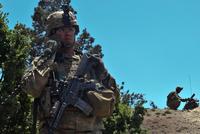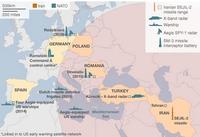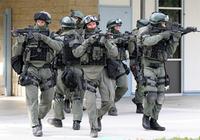-
Enhancing Army capabilities as new threats emerge
Some twenty-eight nations have some type of weapons of mass destruction capability, with some of them having nuclear weapons or nuclear-weapons capability. The nuclear materials in many of these countries are kept in hundreds of sites without global safeguards in place for securing them. A senior American military official described these loose nukes as the “single biggest existential threat to Western survival.” Yet, in a recent exercise, the U.S. response time for deploying 90,000 troops to a crisis area – an area which included loose nukes, other WMDs, or both — took fifty-five days. U.S. military leaders say this is just not good enough.
-
-
Making military wireless networks more robust

DARPA’s Wireless Network Defense program seeks to develop new technologies to help make wireless networks more resilient to unforeseen scenarios and malicious compromise.
-
-
Obama wants U.S. to influence debate over global drone rules
President Barack Obama wants the United States to help formulate global guidelines for the use of drones, especially as other countries, led by China, have begun to invest in their own drone fleets.
-
-
U.S. cancels final phase of European missile defense system

Faced with sequestration-imposed budget cuts, the Pentagon cancels the fourth and final phase of the U.S. European missile defense system. The money made available by the decision would be used to fund the deployment of fourteen additional missile interceptors in Alaska to increase U.S. defense against North Korea’s missile threat. The Pentagon said that the first three phases of the defensive missile deployment in Europe, when completed in 2018, would provide coverage of all of NATO members.
-
-
U.S. to bolster missile defense to meet North Korean threat
The United States is bolstering the country’s missile defense after a series of explicit nuclear threats from North Korea. The Pentagon will announce Monday that it is deploying fourteen additional ground-based interceptors at missile silos in Alaska and California.
-
-
Questions raised about Iron Dome success
MIT professor Ted Postol is at it again: in 1992 he successfully challenged the claims made by the United States, Israel, and Raytheon about the effectiveness of the Patriot missiles in intercepting Iraqi SCUD missiles fired at Israel, and now he is raising similar questions about the accuracy of claims made about the effectiveness of Israel’s Iron Dome anti-rocket system during the 10-day Israel-Hamas war last November, a war code-named Pillar of Defense.
-
-
ACLU looks into the use of military technology by local law-enforcement

Affiliates of the American Civil Liberties Union in twenty-three difference states have filed more than 255 requests for public records in order to determine how many local police departments are using federally subsidized military technology and tactics – technology and tactics which have that have traditionally been used on battlefields overseas such as, most recently, in the Iraq and Afghanistan wars.
-
-
U.S. arms sales, security partnerships to suffer as a result of sequestration cuts
One area where sequestration-mandated budget cuts will be felt sooner rather than later is U.S. support for foreign militaries in Europe, Asia, and the Middle East. Training and security partnership engagements with allies will likely decline as well as the Defense Department must now operate with a $46 billion cut in its budget for fiscal 2013.
-
-
U.S. military “unprepared” for cyberattacks by “top-tier,” cyber-capable adversary: Pentagon

A new Pentagon study concludes that the U.S. military is unprepared for a full-scale cyber-conflict with a top-tier, cyber-capable adversary. The report says the United States must increase its offensive cyberwarfare capabilities, and that the U.S. intelligence agencies must invest more resources in obtaining information about other countries’ cyberwar capabilities and plans. The report says that the United States must maintain the threat of a nuclear strike as a deterrent to a major cyberattack by other countries. The report warns that the Pentagon cannot be confident its military computer systems and communication networks are not compromised because many of the components of these systems and networks are made in countries which pose the main cyberthreat to U.S. national security.
-
-
Enabling small ships to launch and retrieve long-endurance UAVs
About 98 percent of the world’s land area lies within 900 nautical miles of ocean coastlines. Enabling small ships to launch and retrieve long-endurance UAVs on demand would greatly expand the U.S. military’s situational awareness and ability quickly and flexibly to engage in hotspots over land or water. DARPA is seeking companies to develop these systems.
-
-
The impact of sea-level rise on coastal military installations
The Pentagon says that climate-related effects are already being observed at Department of Defense (DoD) installations in every region of the United States and its coastal waters. The effects of climate change will adversely impact military readiness and DoD natural and built infrastructure unless these risks are considered in DoD decisions. A new white paper developed by the Pentagon’s Strategic Environmental Research and Development Program (SERDP) identifies key climate-related policy questions that need to be addressed.
-
-
Developing the next-generation of VTOL aircraft

One of the greatest challenges of the past half century for aerodynamics engineers has been how to increase the top speeds of aircraft that take off and land vertically without compromising the aircraft’s lift to power in hover or its efficiency during long-range flight. DARPA’s new VTOL X-Plane project aims to achieve higher speeds, increased efficiency, and elegant design.
-
-
Saving money and time in developing phased RF arrays
Phased radio frequency (RF) arrays use numerous small antennas to steer RF beams without mechanical movement. These electronics are invaluable for critical DoD applications such as radar, communications, and electronic warfare. These arrays, however, come with a high price tag. Current phased arrays are extremely expensive and can take many years to engineer and build.
-
-
Israel tests advanced Arrow 3 missile defense
Israel and the United States have jointly tested the Arrow 3, a ballistic missile defense system designed to intercept enemy missiles outside the atmosphere. The Arrow 3 is the fourth component of Israel’s layered missile and rocket defense system, which also includes Iron Dome, David’s Sling, and Arrow 2. The Arrow 3 was designed to intercept missiles outside the atmosphere.
-
-
Climate change as a national security issue
In a new report, Harvard researcher is pointing toward a new reason to worry about the effects of climate change — national security. During the next decade, the report concludes, climate change could have wide-reaching effects on everything from food, water, and energy supplies to critical infrastructure and economic security. “The imminent increase in extreme events will affect water availability, energy use, food distribution, and critical infrastructure — all elements of both domestic and international security,” the report’s author says.
-
More headlines
The long view
Bookshelf: Smartphones Shape War in Hyperconnected World
The smartphone is helping to shape the conduct and representation of contemporary war. A new book argues that as an operative device, the smartphone is now “being used as a central weapon of war.”
